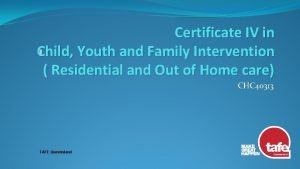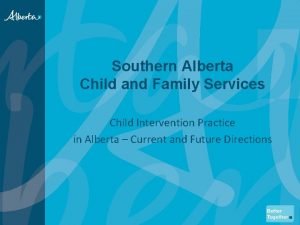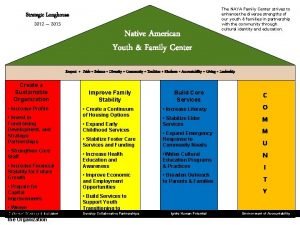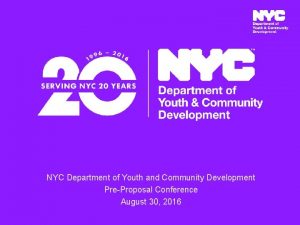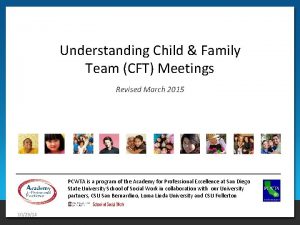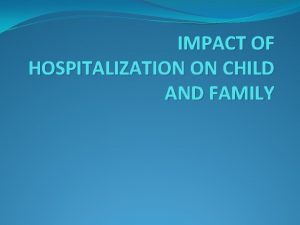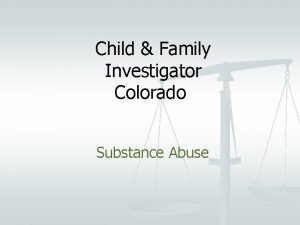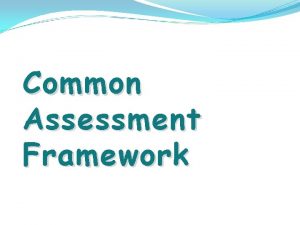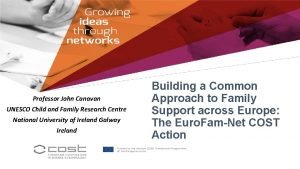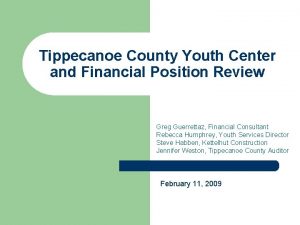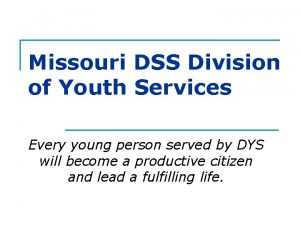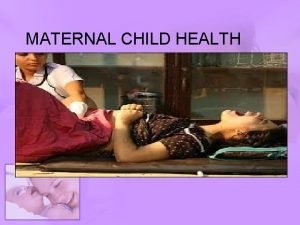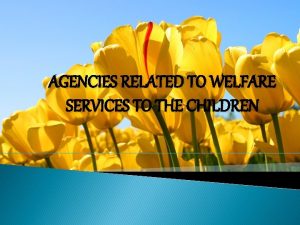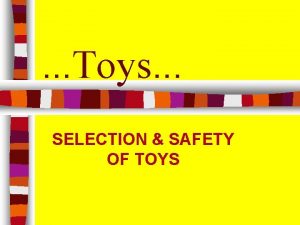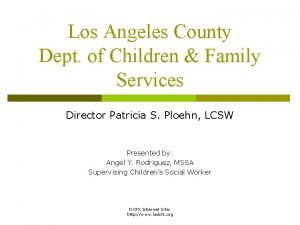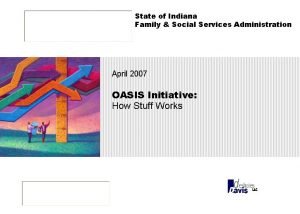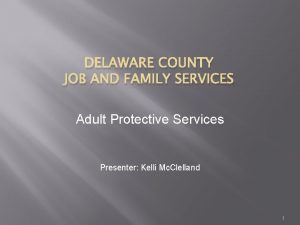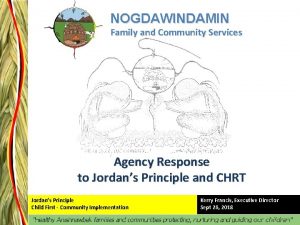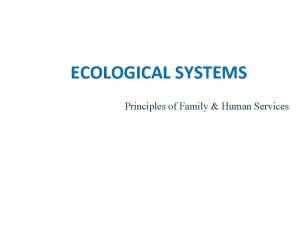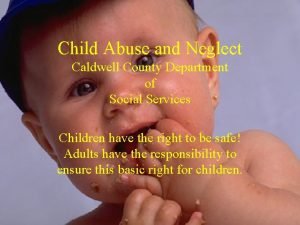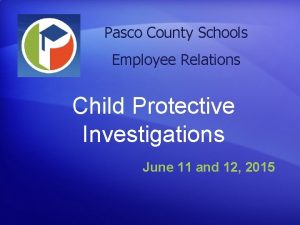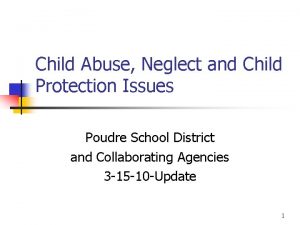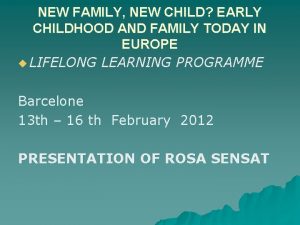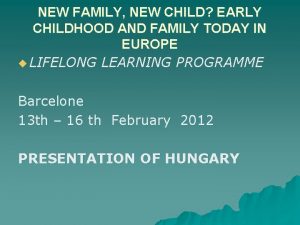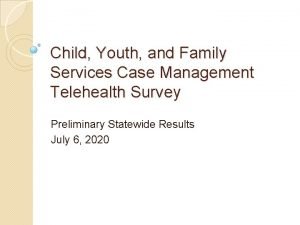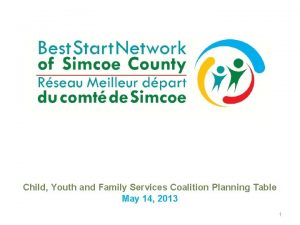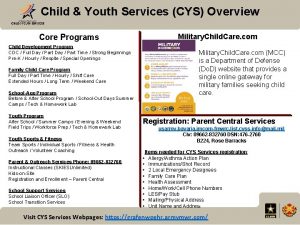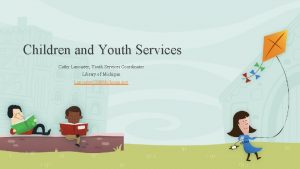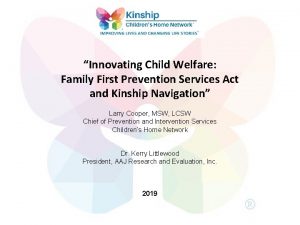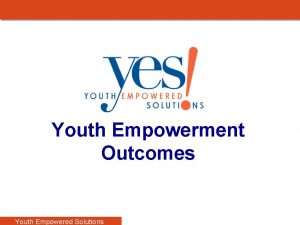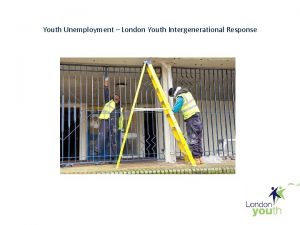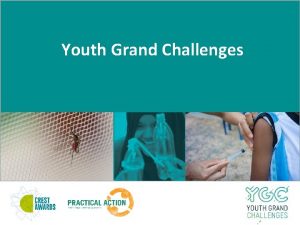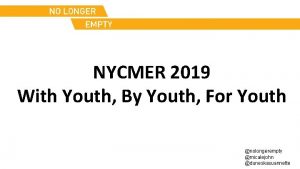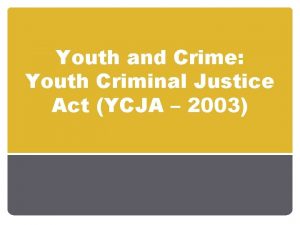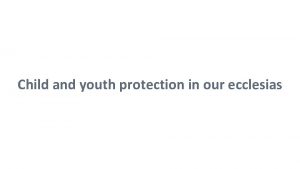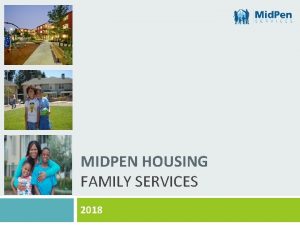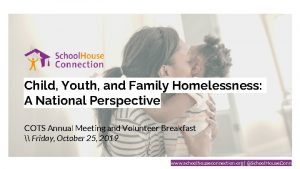The New Child Youth and Family Services Act











![BEST INTERESTS TEST The best interests test (section 74(3) [Child Protection] and section 179(2) BEST INTERESTS TEST The best interests test (section 74(3) [Child Protection] and section 179(2)](https://slidetodoc.com/presentation_image_h2/bed0ba32b1200349509ed27b56007ab6/image-12.jpg)




















- Slides: 32

The New Child, Youth and Family Services Act, 2017 CAROLYN LEACH Counsel, MAG Civil Law Division, MCSS/MCYS Legal Branch PATRIC SENSON Counsel, Office of the Children’s Lawyer June 20, 2018

PURPOSE To provide an overview of the CYFSA, focusing on the following areas: The rights of children and young persons receiving services; Changes to provisions governing child protection; Provisions respecting supports and services for First Nations, Inuit, and Métis children and families; Changes to provisions related to openness.

REVIEW OF THE CHILD AND FAMILY SERVICES ACT Since 2005, there has been a legislative requirement to review the CFSA every 5 years; however comprehensive revisions to the CFSA have not been made since its assent in 1984 A 5 -year review of the CFSA was launched in September 2014 Public sessions were held in 11 cities, including dedicated youth sessions, and more than 100 written submissions were received Feedback was received on ways that the CFSA could be improved, including: Changes to language and terminology; Raising the “age of protection”; Better supporting culturally appropriate services for First Nations, Inuit and Métis children and families

OVERVIEW The CYFSA has a new Preamble and is divided into Parts: CYFSA CFSA Preamble Part I: Purposes and Interpretation Sections 1 and 3 Part II: Children’s and Young Persons’ Rights Part III: Funding and Accountability Sections 2, 4, 27, 28, Part V Part IV: First Nations, Inuit and Métis Child and Family Services Part X Part V: Part III Child Protection Part I Part VI: Youth Justice Part IV Part VII: Extraordinary Measures Part VIII: Adoption and Adoption Licensing Part VII Part IX: Residential Licensing Part IX Part X: Personal Information NEW Part XI: Miscellaneous Matters Part XII: Regulations Part XI 4

CHANGES IN TERMINOLOGY The term “Crown ward” is replaced with the term “child in extended society care” The term “Society ward” is replaced with the term “child in interim society care” The terms “runaway” and “abandoned” have been removed The term “apprehended” is replaced with the term “brought to a place of safety:

KEY NEW PROVISIONS: RIGHTS OF CHILDREN AND YOUNG PEOPLE

THEN AND NOW: THEN– Children’s Rights Under the CFSA • The CFSA established that children in care had rights to: – Visit and communicate with family and others, such as the child’s lawyer, PACY, the Ombudsman, an MPP or MP; – Privacy, religious activities, a plan of care developed with the child’s participation, meals, clothing, medical and dental care, education, recreational and athletic activities – Be consulted and express views when significant decisions are being made – Be informed of their rights, complaints procedures, PACY, review procedures, the rules and responsibilities that apply to them in the placement (once only – upon admission).

THEN AND NOW: NOW– Children’s Rights Under the CYFSA • Rights extended to all children receiving services under the Act, not • • just those in care Rights moved to front end of Act (Part II), emphasizing importance New language and new rights, e. g. , express views “freely and safely”, be engaged in an “honest and respectful dialogue”, have views given “due weight”, “participate” in decisions, raise concerns and recommend changes and receive a response… For kids in care, clarification that rights related to decision-making include decisions with respect to treatment, education, training or work programs, creed (includes religion), community identity and cultural identity, placement; Ongoing right to be informed – not just upon admission but also at regular intervals thereafter

RECOURSE WHEN RIGHTS VIOLATED • Provincial Advocate for Children and Youth (aka PACY/Ontario Child Advocate) – CYFSA requires that children be informed of the existence and role of PACY and how to contact them to request assistance. • Complaints – internal – Residential service providers and societies (requirement continued from CFSA) – Other service providers (new requirement) • Complaints – Child and Family Services Review Board (CFSRB) – Not rights-specific, but overlap with right to be heard in relation to decisions, given reasons • Residential Placement Advisory Committee (not new) (+CFSRB if not satisfied) – Not rights-specific but rights violations could conceivably form basis of child’s dissatisfaction with a placement and evidence in support of a change • Court? – Plan of Care? – Best interests – “any other circumstance”?

KEY NEW PROVISIONS: CHILD PROTECTION

EXPANDING THE AGE OF PROTECTION TO 16 & 17 YEAR OLDS Duty to report – the duty that all persons have to report a reasonable suspicion that a child is in need of protection applies only for children younger than 16. However, a person may made a report in respect of a 16 or 17 year old. 16 & 17 year olds may not be brought to a place of safety without their consent A society may now bring a child protection application in respect of a 16 or 17 year old. 16 & 17 year olds may be found to be in need of protection on the same grounds for protection as other children. The society may now enter into a temporary care agreements (TCA) with respect to 16 & 17 year olds. Societies may enter into a Voluntary Youth Services Agreement (VYSA) with a 16 & 17 year old who requires out-of-home care
![BEST INTERESTS TEST The best interests test section 743 Child Protection and section 1792 BEST INTERESTS TEST The best interests test (section 74(3) [Child Protection] and section 179(2)](https://slidetodoc.com/presentation_image_h2/bed0ba32b1200349509ed27b56007ab6/image-12.jpg)
BEST INTERESTS TEST The best interests test (section 74(3) [Child Protection] and section 179(2) [Adoption] CYFSA) sets out the factors that are to be considered whenever a person is directed in these Parts to make an order or determination “in the best interests of the child”. THEN: Under the CFSA, a list of “circumstances” was provided, with the decision-maker directed to consider those that he or she considered to be relevant, including: The child’s physical, mental and emotional needs The child’s cultural background and religious faith The child’s relationships and emotional ties The importance of continuity in the child’s care The risk that the child will suffer harm The child’s views and wishes, if they can reasonably be ascertained

BEST INTERESTS TEST (cont’d) NOW: the new best interests test in Parts V (Child Protection) and VIII (Adoption) has been changed so that two considerations are now mandatory. Specifically, the decision-maker is directed to: consider the child’s views and wishes, and give them due weight in accordance with the child’s age and maturity, unless they cannot be ascertained; in the case of a First Nations, Inuk or Métis child, consider the importance of preserving the child’s cultural identity and connection to community; and consider any other circumstance of the case that the decision maker considers relevant. The list of considerations is similar to the CFSA with slightly different lists in Part V & Part VIII. Both lists include the child’s cultural and linguistic heritage, race, ancestry, place of origin, colour, ethnic origin, citizenship, family diversity, disability, creed, sexual orientation, gender identity, and gender expression.

NEW TEST FOR ACCESS TO CHILDREN IN EXTENDED SOCIETY CARE Both the CFSA and the CYFSA contain a presumption against access to a child in extended society care (previously a “Crown ward”). The court may not make or vary an access order to a child in extended society care unless specific conditions are satisfied (“the test for access”). THEN: Under the CFSA, an order for access to a Crown ward could not be made unless the person seeking access could satisfy the court that: The relationship between the person and the child was beneficial and meaningful to the child; and The ordered access would not impair the child’s future opportunities for adoption. Prior to 2011, Crown wards who were subject to access orders could not be adopted. After 2011, these children could be adopted, but their access orders would be automatically terminated upon their placement for adoption. The person who had the right of access (the “access holder”) would

NEW TEST FOR ACCESS TO CHILDREN IN EXTENDED SOCIETY CARE (cont’d) NOW: The CYFSA (s. 105) provides that a court shall not make or vary an access order with respect to a child who is in extended society care unless the court is satisfied that the order would be in the child’s best interests. A modified best interest test applies to this determination. In addition to the best interests test above, the court shall also consider whether the relationship between the person and the child is beneficial and meaningful to the child and, if relevant, whether the ordered access will impair the child’s future opportunities for adoption. The Act clarifies that a sibling of the child may apply for access. The CYFSA requires that where an access order is made respecting a child in extended society care, the order shall specify the person who has the right and the person with respect to whom access is granted

EXTRA-PROVINCIAL CHILD PROTECTION ORDERS Under the CYFSA, a children’s aid society has the authority to: bring a child to a place of safety who is the subject of a temporary or final extra-provincial child protection order respecting their custody, and return the child to the extra-provincial child protection authority or other person named in the order.

KEY NEW PROVISIONS FIRST NATIONS, INUIT AND METIS CHILDREN AND FAMILY SERVICES

FIRST NATIONS, INUIT AND MÉTIS CHILDREN AND FAMILIES The CYFSA uses the terms “First Nations”, “Inuk”, and “Métis”. o The Act repeals the definition of “Indian” and “Native person” in the CFSA. o Children and persons may self-identify as First Nations, Métis or Inuit and may identify with more than one band or community. o This approach is inclusive of status and non-status First Nations, Métis and Inuit persons.

FIRST NATIONS, INUIT AND MÉTIS CHILDREN AND FAMILIES (cont’d) The term “Native Community” is repealed in favour of “First Nations, Inuit, or Métis Community”. o The Minister has authority to list First Nations, Inuit and Métis communities in a regulation. Once listed, the communities would have certain rights and responsibilities under the CYFSA, like bands (e. g. notice and participation in child protection proceedings, consultation by service providers). o A regulation provision listing Inuit Tapiriit Kanatami (ITK) as a FNIM community will come into force on July 1. 2019. All references to a child’s or young person’s bands and First Nations, Inuit or Métis communities in the CYFSA include any band or listed community of which the child or young person is a member or with which they identify.

FIRST NATIONS, INUIT AND MÉTIS CHILDREN AND FAMILIES (cont’d) Customary Care: o The CYFSA requires societies to demonstrate that they have made all reasonable efforts to pursue customary care placements for First Nations, Inuit, and Métis children and youth who are in need of protection and cannot remain in or return to their parents’ care. Review of Act: o The mandated five-year review of the Act is expanded to require reviews to address First Nations, Inuit and Métis issues.

REGULATIONS SPECIFIC TO FIRST NATIONS, INUIT AND MÉTIS CHILDREN AND FAMILIES Regulations are in place that address a number of matters including: o Interpretation of First Nations, Inuk or Métis child for the purposes of the Act o Determining a child’s bands and FNIM communities for the purposes of the Act o Consultations between Children’s Aid Societies and a child’s bands and FNIM communities o Transition provisions concerning child protection proceedings o Listing Inuit Tapiriit Kanatami (ITK) as a FNIM community

KEY NEW PROVISIONS: OPENNESS

4 MAIN CHANGES IN OPENNESS Changes in the Best Interest Test Changes to the Service Requirements and Involvement of the OCL A New Openness Scheme for First Nation, Inuit, and Metis (FNIM) Children Direction on what happens to Openness after a Disruption or a Breakdown

CHANGES TO THE BEST INTERESTS TEST Similar to the Best Interests Test under s. 74, two considerations are mandatory: o Child’s views and wishes are to be given due weight in accordance with their age and maturity, unless they cannot be ascertained o For an FNIM child, the importance, in recognition of the uniqueness of First Nations, Inuit and Metis cultures, heritages and traditions, of preserving the child’s cultural identity and connection to community

CHANGES TO THE BEST INTERESTS TEST (Cont. ) CFSA Language CYFSA Language The child’s cultural background and The child’s race, ancestry, place of religious faith in which the child is being raised. The child’s relationships by birth or through an adoption order. origin, colour, ethnic origin, citizenship, family diversity, disability, creed, sexual orientation, gender identity, and gender expression. Also the child’s cultural and linguistic heritage. The child’s relationships and emotional ties to a parent, sibling, relative, other members of the child’s extended family or community.

CHANGES TO THE SERVICE/NOTICE REQUIREMENT TO THE CHILD AND OCL Service of Notices s. 195(4)(b) Service of Applications s. 194(30), s. 196(3), s. 197(4)(a), s. 198(4), s. 207(5) Notices of an Intention to Place must be served on the OLC as part of effecting service on a child All Notices to a child, including where a child is a Recipient must be served on the OCL Children under the age of 12 no longer have to be served directly. They are served by serving the OCL and the child’s lawyer if any Children over the age of 12 need to be served directly in addition to the other requirements All Applications for Openness must be served on the OCL. Includes: o CAS Openness Applications where no access order o Original Openness Applications brought by any other person o Openness Applications brought under the FNIM sections o Any Applications to vary or terminate openness orders.

OTHER OCL RELATED CHANGES OCL is provided with jurisdiction to provide legal representation to a child under this part if it is the opinion of the OCL that representation would be appropriate. o Significant change, as standing has been an issue in Motions of Directions, contested adoption applications, etc. o Previous provision only allowed the Court to appoint in openness proceedings, now the OCL can be appointed in any proceedings under this part of the CYFSA o The OCL is no longer required to wait until a court order to assign counsel when seeking openness to a sibling who is not represented

CREATION OF A NEW OPENNESS PROCEDURE FOR FNIM CHILDREN Obligation to Consider Connections o CYFSA includes a provision that when planning for the adoption of a FNIM child, must consider the importance of developing or maintaining the child’s connection to band and/or communities (Section 187 (1)) • Obligation to Consider Openness o Mandatory to consider benefits of openness agreements with band/communities (Section 187(2)) o Mandatory to consider benefits of an openness order with band/communities if the child is in extended care (Section 187(2))

FNIM APPLICATIONS FOR OPENNESS Who Can Bring One? o The Child - s. 197(2) o Representative chosen by each of the child’s bands/communities – s. 197(2) o The Society – s. 197 (6) Do you need an access order? o No, an openness application can be brought under this section irrespective of whether or not there is an access order in place - s. 197(1) How will the Child, Band/Community be Notified? o Similar to the current notice process when an access order is in effect o Band/community representative will get notice o The child will receive notice as per service requirements

FNIM APPLICATIONS FOR OPENNESS (CONT. ) What is the Limitation Period? o Within 30 days from date notice is given – s. 197 (3) and (6) What is the test? o The order must be in the best interests of the child o Child 12 and older must consent o The openness order will help the child: o Develop or maintain connection with the child’s FNIM cultures, heritages and traditions o Preserve the child’s cultural identity and connection to the community What about the AP’s ability to comply? o The Court must still consider the ability of an adoptive parent to comply with the openness order

YOU NEED A DESIGNATED BAND/COMMUNITY FOR THIS PROCESS TO WORK The Agency will not have anyone to serve with the notices under s. 197 if there isn’t a designated Band/Community The child/Society can only bring an application for openness to the representative designated by the Band/Community These applications will require considerable coordination with the child’s bands/communities to discuss how the child’s cultural connections can best be maintained Ideally many of these discussions should take place at the stage when the extended care order is made

MAINTENANCE OF RELATIONSHIPS Section 220 – Clarifies what happens to openness arrangements upon adoption disruption or adoption break down: o Openness orders continue in force and effect unless varied or terminated o Obligation on Societies to continue facilitating openness orders and agreements if children returned to their care o Requires Societies to consider whether they should apply for an access order
 Child, youth and family services act, 2017
Child, youth and family services act, 2017 Rpl tafe qld
Rpl tafe qld Bza first nation
Bza first nation Southeast cfs
Southeast cfs Lorain county child protective services
Lorain county child protective services Kina gbezhgomi child and family services
Kina gbezhgomi child and family services Native american youth and family center
Native american youth and family center Macbeth act 2 summary
Macbeth act 2 summary Nyc department of youth
Nyc department of youth Cft meeting
Cft meeting Impact of hospitalization on the child and family
Impact of hospitalization on the child and family Child family investigator colorado
Child family investigator colorado Team around the family
Team around the family Unesco child and family research centre
Unesco child and family research centre Left child right sibling tree
Left child right sibling tree Tippecanoe county youth services
Tippecanoe county youth services Dys missouri
Dys missouri Red cross youth services
Red cross youth services Enfield youth services
Enfield youth services Maternal and child health services
Maternal and child health services Agencies related to child welfare
Agencies related to child welfare New pathways for youth jobs
New pathways for youth jobs Child protection and toy safety act
Child protection and toy safety act Child care and protection act 3 of 2015
Child care and protection act 3 of 2015 Conclusion on topic family
Conclusion on topic family Children and family services los angeles
Children and family services los angeles Indiana family and social services administration
Indiana family and social services administration Adult protective services delaware
Adult protective services delaware Nogdawindamin
Nogdawindamin Exosystem
Exosystem Caldwell county dss
Caldwell county dss Pasco county child protective services
Pasco county child protective services Crs 19-3-304
Crs 19-3-304

